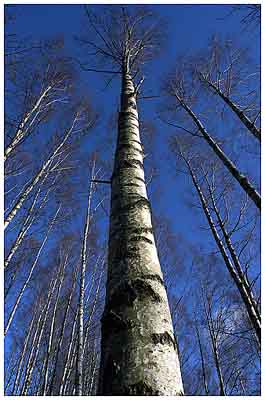 |
||
Click any thumbnail to get a bigger picture. It will open in a smaller window |
Above: Visible light All images: © Bjørn Rørslett/NN February, 2000 |
EIR images shot with 15 mm f/5.6 Nikkor on Nikon F5 and cropped to match D1 image |
IR Photography With Ektachrome Infrared (EIR)
 |
||
Click any thumbnail to get a bigger picture. It will open in a smaller window |
Above: Visible light All images: © Bjørn Rørslett/NN February, 2000 |
EIR images shot with 15 mm f/5.6 Nikkor on Nikon F5 and cropped to match D1 image |
I did most of my earlier infrared work on Kodak's IE (2443), until my stockpiled supply emptied. Using IE was a hassle because of the film's unpredictability, its coarse grain, and the old-fashioned and expensive E-4 method needed to process it. However, IE did produce some very nice images and had an extremely detailed rendition of reds and yellows. The only currently available IR false-colour film is Infrared Ektachrome (EIR) from Kodak. This can be E-6 processed to give slides, or even cross-processed i C-41 if weirdly-coloured negatives are called for. Compared to its forerunner the colours of EIR are garish, lacking in detail and nuances - foliage is either red or not red, for example. Probably the colour rendition will improve with AR-5 processing (recommended by Kodak), but again, very few labs offer this process and it is hugely expensive and turn-around is very long indeed. So E-6 is the only viable alternative. EIR needs stronger filtration during exposure than did the old IE. Formerly I preferred a Kodak Wratten #12 filter for IE, a filter which produced vibratingly saturated colurs for nature and landscape photography. Nikon's Y48 is a medium deep yellow filter that delivered quite similar results with IE as did Wratten #12. However, the test shots depicted above indicates that Y48 renders the scene too cold so an orange filter (O56) might be better suited for nature work.
Camera and light meters are not calibrated for IR, and the IR fraction of incident light is variable. Thus, there will always be some trial and error in exposing IR colour film. I have however obtained good and fairly reliable IR exposures by assigning EIR an EI (=Exposure Index, often mistakenly designated "ISO" by end users) of 320 for my F5 camera. Bracketing within a 1/2 stop of this recommendation will virtually guarantee a useful image. Please note that this EI includes the filter factor for the filters demonstrated here. When shooting in dull weather, under overcast skies, or the main subject is damp or wet, EIR may need a +1 stop correction so the basic EI then becomes 160. On the other hand, if clear sky occupies a big portion of the scene, EI should be increased to 640 to avoid washing out the highlights.
Because its spectral sensitivity extends all the way from 300 to 900 nm, EIR may be applied to UV as well as IR photography. Some interesting UV results can be obtained with this film.
Since this review first was written, I've shot a lot more of EIR film, and reluctantly come to the conclusion that this film is way too problematic to use for nature photography. I modified filtration using Y-52 instead of the Y-48 Nikon filter, and this cut back on the coldness of its colour rendition. However, reds were still garish and non-differentiated compared to the delicate rendition of old IE film.
| To Top | Far Side | UV | *IR | Gallery | Reviews | Lenses | Links | Personal | Professional | Start | |
Last Update 1 October, 2002 |